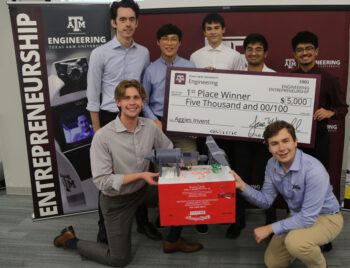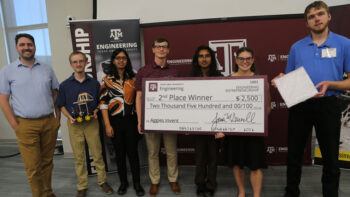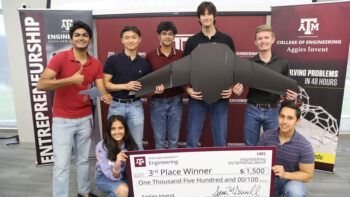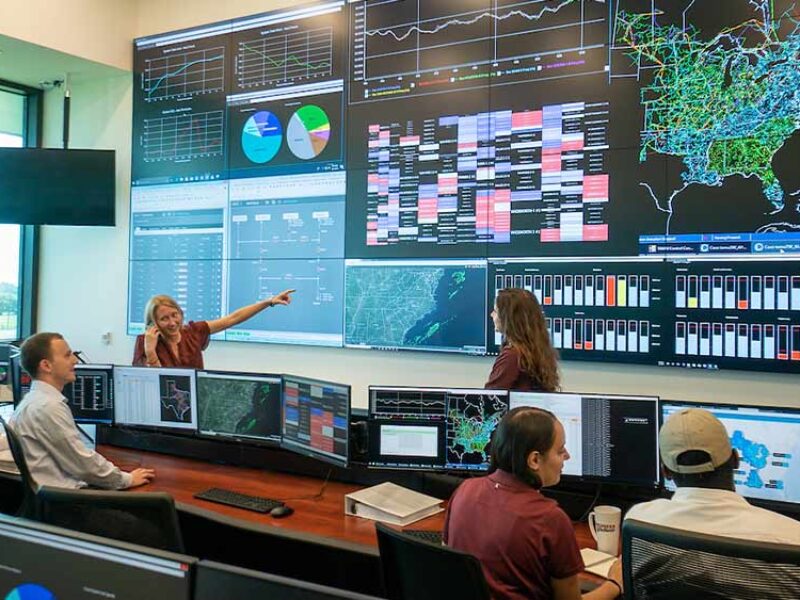Students Tackle National Security Challenges At Aggies Invent

The United States depends on well-trained experts and advanced technology to address threats to our safety. Whether in aviation systems, cybersecurity or weapons detection, the country depends on national security for a safer world.
Texas A&M University students tackled some of these national security issues last weekend during the College of Engineering’s Aggies Invent.
Hosted by the Meloy Engineering Innovation and Entrepreneurship Program (MEIEP) and sponsored by Los Alamos National Laboratory (LANL), students formed groups solving design problems from unexploded ordnance location to unmanned ordnance disablement. Students had 48 hours to develop a solution, design a prototype, and showcase their innovative and creative abilities to a panel of judges.
The teams that secured the top three positions at Aggies Invent were Team BioTect, first place, earning $5,000; Team Paladin, second place, earning $2,500; and Team Sky Guardians, third place, earning $1,500.
Freshman general engineering student Agrim Kar was a member of the first-place Team BioTect. His team’s need statement was to design a device that would detect landmines that are either physical or underground in various terrains.
“Basically, what we did is we utilized these strands of E. coli (the ones that are safe for humans in the environment), and we encapsulated them in a solid gel-like substance,” he said. “We were able to drop the particles without having an effect on the environment while also being able to detect landmines.

“When they would come into contact with a landmine, the E. coli strands are genetically engineered to detect TNT and DNT. It would absorb them, and it would emit a fluorescent blue light, and afterwards we would send in a second UAV. We would detect blue light, pin it for a location, and send it to our database.”
Biomedical engineering freshman Sarah Buchanon, who was on Team Paladin, said the event was “really exciting,” and that she “enjoyed the teamwork aspect of it, and just the excitement of having to create something in a short timeline.
Senior aerospace engineering major Marshall Mann was a part of Team Sky Guardians, and said his team’s need statement was “identifying and physically marking unexploded ordinances in any situation.”

“My team used a method that was actually introduced in a few of our entrepreneurship classes,” said. “We considered multiple designs and used a decision matrix to narrow down a design, and then from that design, we spent the entire time trying to justify it, refine it and make the best solution possible.”
Mann said working on this event “felt really inspiring.”
“Getting to interact with a bunch of different classifications, people from different majors, it really made me consider the aspects of my degree that aren’t really aerospace,” he said. “It really showed me that being an engineer is not just about your major, it’s also about being able to solve challenges that you’ve never encountered before.”
The next Aggies Invent will take place November 10-12, focusing on the increased incidence of brain cancer found in doctors and radiologists caused by radiation exposure. This need statement won the Problems Worth Solving pitch competition hosted by the MEIEP in April 2023 and will be sponsored by Phillips 66.
Media contact: Alyson Chapman, achapman@tamu.edu





